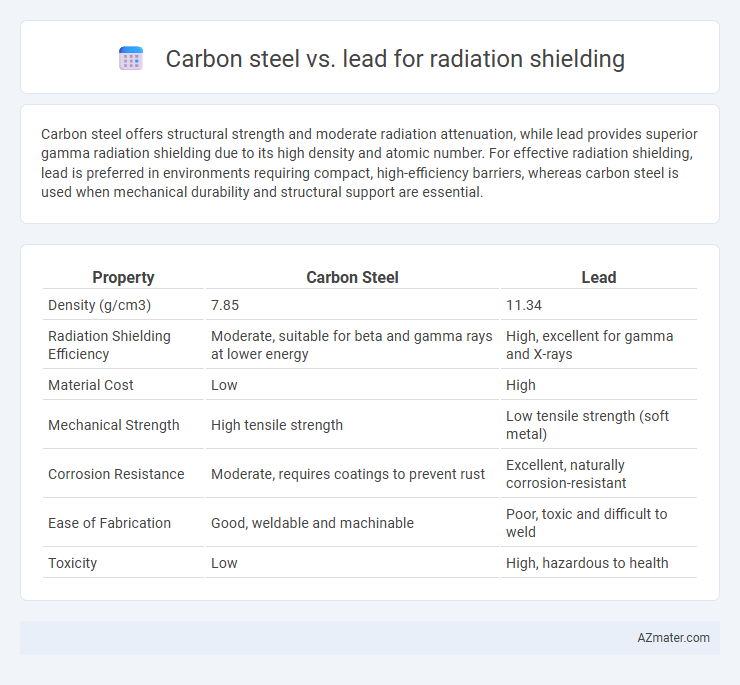Carbon steel offers structural strength and moderate radiation attenuation, while lead provides superior gamma radiation shielding due to its high density and atomic number. For effective radiation shielding, lead is preferred in environments requiring compact, high-efficiency barriers, whereas carbon steel is used when mechanical durability and structural support are essential.
Table of Comparison
| Property | Carbon Steel | Lead |
|---|---|---|
| Density (g/cm3) | 7.85 | 11.34 |
| Radiation Shielding Efficiency | Moderate, suitable for beta and gamma rays at lower energy | High, excellent for gamma and X-rays |
| Material Cost | Low | High |
| Mechanical Strength | High tensile strength | Low tensile strength (soft metal) |
| Corrosion Resistance | Moderate, requires coatings to prevent rust | Excellent, naturally corrosion-resistant |
| Ease of Fabrication | Good, weldable and machinable | Poor, toxic and difficult to weld |
| Toxicity | Low | High, hazardous to health |
Introduction to Radiation Shielding Materials
Radiation shielding materials must effectively absorb or block ionizing radiation to protect personnel and sensitive equipment. Carbon steel, with its high density and significant structural strength, provides a durable barrier primarily against gamma rays and X-rays, making it suitable for industrial and medical applications. Lead offers superior radiation attenuation due to its higher atomic number and density, making it a preferred choice for compact shielding in environments requiring maximum protection against gamma and X-ray radiation.
Understanding Radiation: Types and Hazards
Carbon steel is less effective than lead in shielding against gamma rays and X-rays due to its lower atomic number and density, which impacts its ability to attenuate high-energy radiation. Lead's high density and atomic number make it a superior barrier against ionizing radiation types such as gamma rays and X-rays, significantly reducing exposure hazards in medical and industrial settings. Understanding the physical properties of shielding materials is critical for protecting against the biological hazards posed by penetrating radiation types.
Key Properties of Carbon Steel
Carbon steel provides significant advantages as a radiation shield due to its high density and mechanical strength, which effectively attenuate gamma rays and X-rays. Its durability and resistance to deformation under high stress make it suitable for structural applications in radiation environments. Unlike lead, carbon steel offers enhanced structural integrity and is less toxic, making it preferable in safety-critical settings.
Key Properties of Lead
Lead exhibits high density (11.34 g/cm3) and excellent radiation shielding capabilities, effectively attenuating gamma rays and X-rays due to its high atomic number (Z=82). Its malleability allows for easy shaping and installation in protective barriers, making it a preferred material in medical and industrial radiation shielding applications. Unlike carbon steel, lead's superior attenuation reduces required thickness for equivalent protection, optimizing space and weight in shield design.
Radiation Attenuation Mechanisms
Carbon steel attenuates radiation primarily through photoelectric absorption and Compton scattering, benefiting from its moderate density and high atomic number elements like iron to reduce gamma and X-ray penetration. Lead, with a higher atomic number (82) and density (11.34 g/cm3), provides superior attenuation by significantly enhancing photoelectric absorption, making it highly effective against gamma rays and X-rays. The effectiveness of radiation shielding depends largely on material density and atomic number, with lead outperforming carbon steel in stopping gamma radiation due to stronger photon interaction mechanisms.
Comparative Shielding Effectiveness: Carbon Steel vs Lead
Lead outperforms carbon steel in radiation shielding due to its higher atomic number (82) and density (11.34 g/cm3), providing superior attenuation of gamma rays and X-rays. Carbon steel, with a lower atomic number (around 26 for iron) and density (~7.85 g/cm3), requires greater thickness to achieve comparable protection, making lead more space-efficient for high-energy radiation shielding. Despite carbon steel's mechanical strength and structural benefits, lead remains the preferred material for effective radiation attenuation in medical and industrial applications.
Health and Environmental Considerations
Carbon steel offers structural strength but lacks the high radiation attenuation properties of lead, making lead a preferred material for radiation shielding in medical and industrial settings. Lead's toxicity poses significant health risks, including lead poisoning and environmental contamination, requiring strict handling protocols and disposal measures to minimize exposure. Choosing carbon steel may reduce environmental hazards but often necessitates thicker shields or supplementary materials to achieve comparable protection.
Cost and Availability Analysis
Carbon steel offers a cost-effective and widely available option for radiation shielding due to its abundant production and lower raw material expenses compared to lead. Lead, while highly effective at radiation attenuation, is more expensive and faces stricter regulations due to its toxicity, limiting its accessibility in many applications. The economic advantage and easy procurement of carbon steel make it a preferred choice for large-scale or budget-conscious shielding projects.
Applications and Industry Preferences
Carbon steel is widely used in medical radiology and nuclear power plant shielding due to its high strength, durability, and cost-effectiveness, providing effective attenuation of gamma and X-rays. Lead remains the preferred material in industrial radiography, radiopharmaceutical facilities, and radiation therapy rooms because of its exceptional density and superior radiation attenuation properties, particularly for gamma radiation. Industry preferences often balance the specific radiation shielding requirements with weight constraints, environmental concerns, and regulatory standards, leading to selective use of carbon steel where structural integrity and cost play vital roles, while lead dominates applications demanding maximum radiation protection.
Future Trends in Radiation Shielding Materials
Emerging radiation shielding materials favor lightweight and sustainable options over traditional carbon steel and lead, emphasizing composites embedded with tungsten or bismuth nanoparticles that offer superior attenuation with reduced environmental impact. Research is advancing toward hybrid shields combining carbon fiber reinforced polymers with advanced metal alloys to enhance durability and adaptability in space and medical applications. Innovative materials integrating nanotechnology and smart sensors are set to revolutionize radiation shielding by providing real-time monitoring and self-healing capabilities, reducing reliance on toxic lead-based shields.

Infographic: Carbon steel vs Lead for Radiation shield
 azmater.com
azmater.com